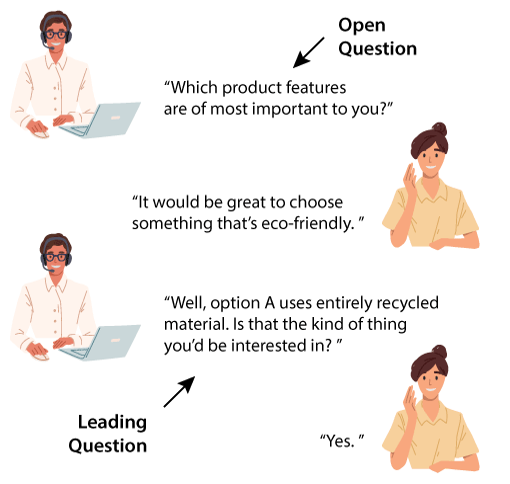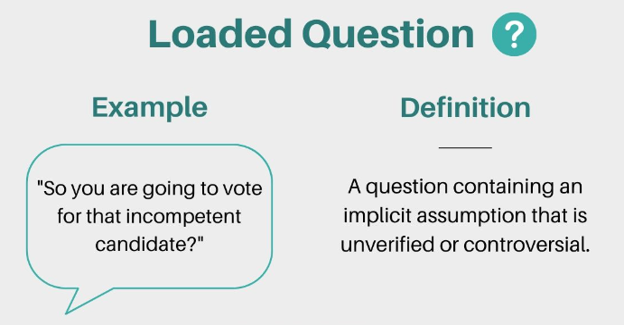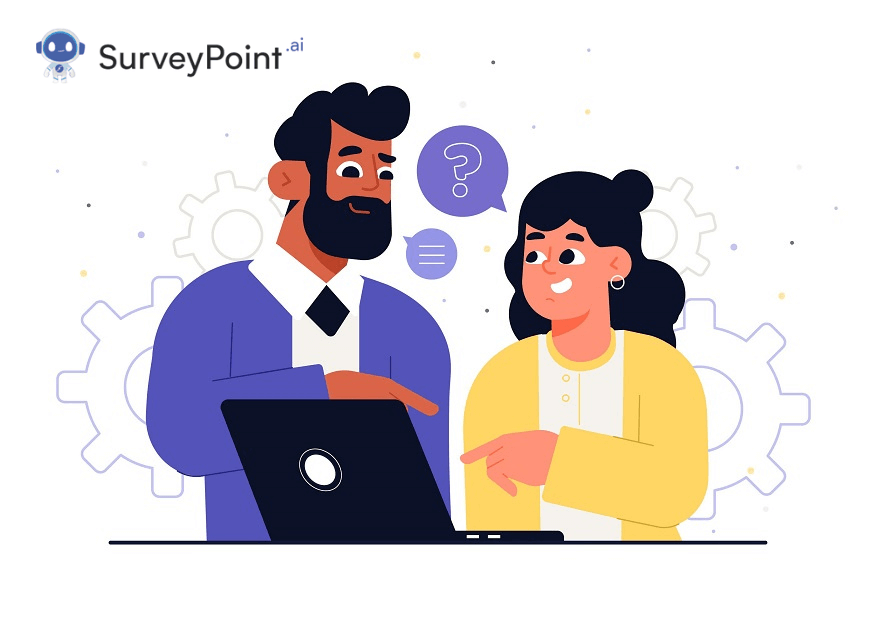
As a survey creator, it is important to know what customers or employees think. It could be bad for your surveys if you ask questions that make people answer in a certain way without their knowledge. The responses could be wrong and lead to bad outcomes; such questions are known as leading questions.
As the name suggests, leading questions lead the survey participant to answer in a certain way because of how they are framed. Because they are worded in a manner that elicits a particular response that might be favorable to the researcher. But it is to be noted that such responses are not accurate and lead to false data!
Such questions sway respondents towards a particular choice between two products or services rather than leaving them the option to not choose.
What kind of questions are these? Let’s dive into a few examples!

Examples
Let’s take a look at the following examples to gain knowledge on how leading questions are identified.
1. Is following all the rules important?
Here, the question is framed in a suggestive way, dictating the respondent rather than asking them.
2. Why shouldn’t one be involved in their community?
Here, the question is framed in a way to nudge the respondent towards a specific answer.
3. Should everyone be treated equally?
Here, the question is more of a statement that makes an assumption beforehand.
4. Are you kind to others?
Here, the question has left no scope for an opinion, and the information gathered from survey questions might not be of any help.
ALSO READ: Questionnaire vs Survey in Research: Understanding the Differences
Types of Leading Questions
A leading question is a type of question that hints at the answer or encourages a particular response. There are a few types:
1. Closed-ended Questions: Such questions can have a simple answer of a “yes” or “no”. For example, “Do you like the new movie?”
2. Loaded Questions: These questions contain an implied assumption or accusation. For example, “Have you stopped cheating on tests?”
3. Suggestive Questions: Questions of this sort call for a certain answer or opinion. For example, “Don’t you think the new movie is great?”
4. Hypothetical Questions: Ask the respondent to consider a hypothetical situation. For example, “If you could go anywhere in the world, where would you go?”
5. Assumption-based Questions: These are questions that make an assumption about the answer and then ask for confirmation. These questions are usually used to get someone to agree to something or to have a conversation about an opinion or thought.
Examples of assumption based leading questions include:
“You must be really excited about the new project, right?”
“You must be feeling extremely overwhelmed at the moment, right?”
ALSO READ: How to Craft Effective Brand Survey Questions?
Characteristics of a Leading Question
As the name suggests, leading questions nudge the respondents to answer in a particular way. The following characteristics have been identified:
- The questions are intentionally framed in such a way that they suggest answers instead of gathering information from the participants.
- The question is built on the facets of an assumption and is reflected thoroughly.
- Leading questions give more recognition to the personal input of the respondents instead of the information.
- These questions can be forceful or dominating in nature, in order to gather a preconceived feedback from the respondent.
- To learn more about the effects of a situation, leading questions are used.
How to Avoid Leading Questions?
Take a look at the following pointers that will help you frame survey questions that are not leading to respondents:
- Start the questions with a neutral phrase, such as “What,” “How,” or “When.”
- Avoid using words or phrases that suggest a certain answer, such as “Don’t you think that…?” or “Isn’t it true that…?”
- Ask questions that can’t be answered with a simple “yes” or “no.”
- Avoid double-barreled questions that ask respondents to answer two separate questions at once.
- Do not ask loaded questions that contain assumptions or implications.
- Prevent making respondents feel uncomfortable or offended by such questions.
- Ask questions relevant to the purpose of the survey that will provide useful information.
ALSO READ: Conducting An Online Focus Group Interview: 6 Easy Steps
What Distinguishes Leading From Loaded Questions?
Although leading questions and loaded questions both attempt to sway the respondent’s answer, they differ in some ways. These questions subtly encourage the respondent to provide a specific response. While loaded questions tend to be complicated and involve an assumption.
For example, “Did he hit you with a shovel?” is a leading question, while “Have you stopped beating your spouse?” is a loaded question.
To avoid confusion between these types of questions, it is important to be clear and neutral in the phrasing of questions in surveys or interviews.

Conclusion
The whole purpose of the survey is to gather relevant information from the participants. If the survey is filled with leading questions, then the creators will exploit the most important tool for gathering information.
One can take measures to ensure that there are no biases in the questions and answers of the survey. Options can be provided to the respondent so that they can choose their preferred answer, which reflects or indicates their opinion on the matter.
Intricate research design tools shall be employed to frame the questions to make sure that the survey gathers information relevant to the purpose of the research.
Interested In Sending Your Own Surveys?
Explore our solutions that help researchers collect accurate insights, boost ROI, and retain respondents using pre-built templates that don’t require coding.




